2003 PONTIAC GRAND PRIX run flat
[x] Cancel search: run flatPage 55 of 378
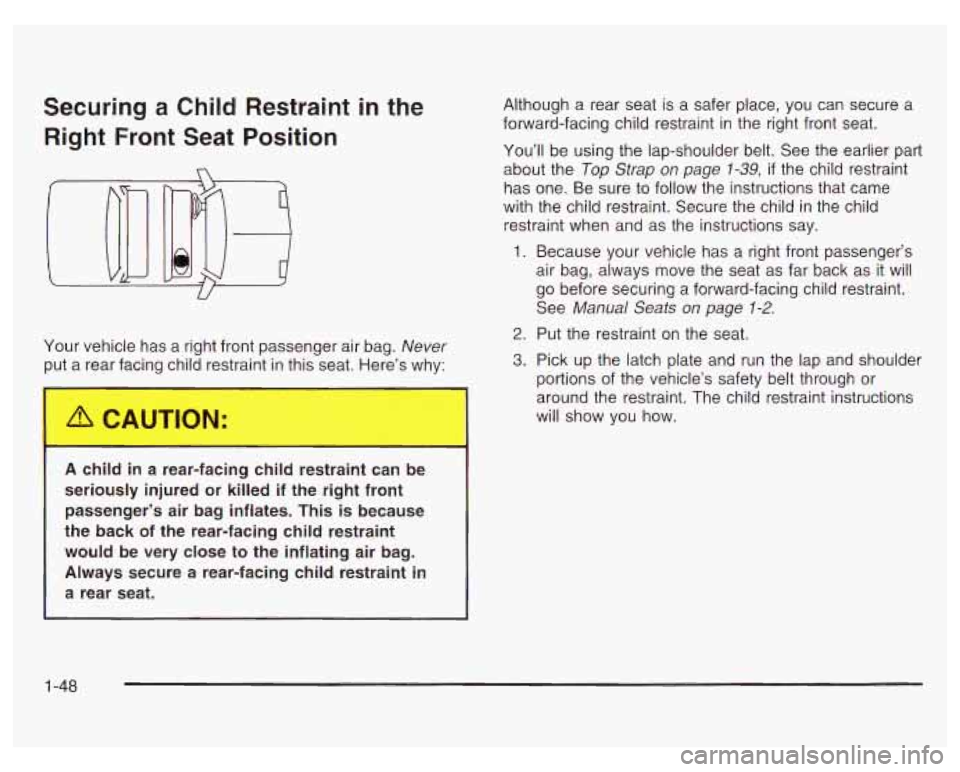
Securing a Child Restraint in the Right Front Seat Position
Your vehicle has a right front passenger air bag. Never
t a rear facing child restraint in this seat. Here’s why:
I A CAUTION:
A child in a rear-facing child restraint can be
seriously injured or killed
if the right front
passenger’s air bag inflates. This
is because
the back of the rear-facing child restraint
would be very close to the inflating air bag.
Always secure
a rear-facing child restraint in
a rear seat.
Although a rear seat is a safer place, you can secure a
forward-facing child restraint in the right front seat.
You’ll be using the lap-shoulder belt. See the earlier part
about the Top Strap on page
7-39, if the child restraint
has one. Be sure to follow the instructions that came
with the child restraint. Secure the child in the child
restraint when and as the instructions say.
1. Because your vehicle has a right front passenger’s
air bag, always move the seat as far back as it will
go before securing a forward-facing child restraint.
See Manual Seats on page
1-2.
2. Put the restraint on the seat.
3. Pick up the latch plate and run the lap and shoulder
portions of the vehicle’s safety belt through or
around the restraint. The child restraint instructions
will show you how.
1 -48
Page 108 of 378

Assist Handles
An assist handle with a reading lamp is located over
each rear side window. The handle can be used to help
you get in or out
of the vehicle. Press the reading
lamp to turn it on. Press
it again to turn it off.
Purse or Litter Bag Holder
On the front of the center console, to the right of the
accessory power outlet, there is a hook that can be used
to hold a purse or litter bag.
Rear Storage Area
If you have a trunk access panel, you will also have a
pull down armrest that contains an open storage bin and
two cupholders.
Convenience Net
The vehicle may have a convenience net. You’ll see it
on the back wall of the trunk.
Put small loads, like grocery bags, behind the net. It can
help keep them from falling over during sharp turns or
quick starts and stops. The
net isn’t for larger, heavier loads, which should be
stored
in the trunk as far forward as possible.
You can unhook the net
so that it will lie flat when
you’re not using it.
Trunk Access Panel
If the vehicle has rear seat armrests, you will also have
a trunk access panel.
This feature allows access to the trunk from the rear
seat area. To use the trunk access panel, pull the rear
armrest down, unlock the access panel with the
ignition key and pull it down.
2-41
Page 148 of 378
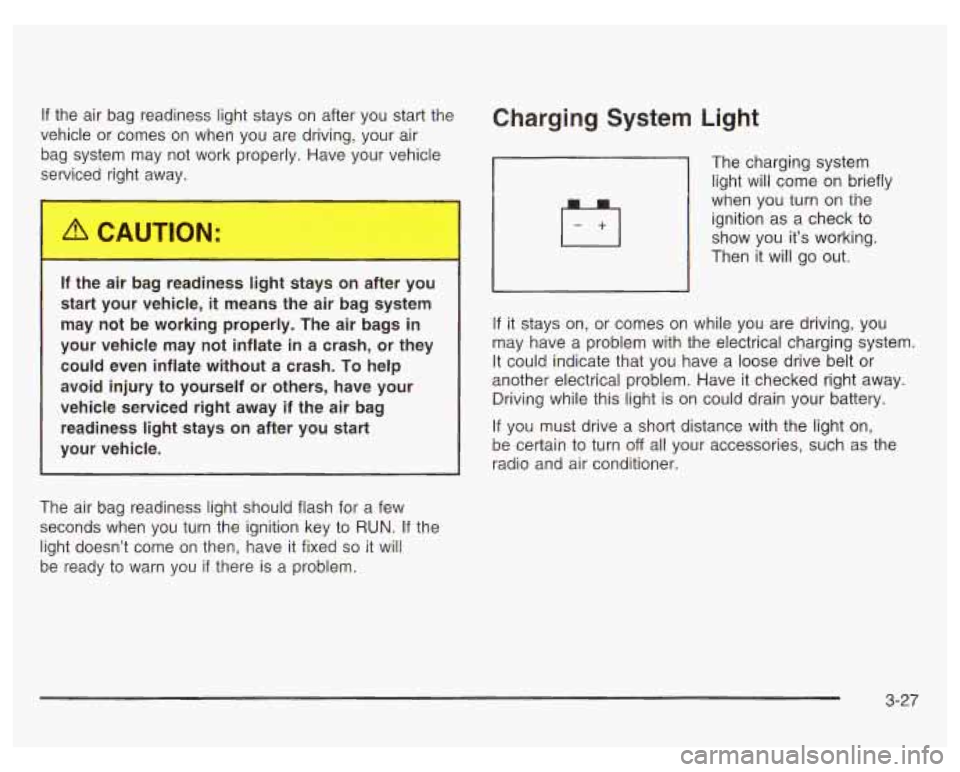
If the air bag readiness light stays on after you start the
vehicle or comes on when you are driving, your air
bag system may not work properly. Have your vehicle
serviced right away.
If the air bag reai.---less light
s 1s on after you
start your vehicle,
it means the air bag system
may not be working properly. The air bags
in
your vehicle may not inflate in a crash, or they
could even inflate without a crash. To help
avoid injury to yourself or others, have your
vehicle serviced right away if the air bag readiness light stays on after you start
your vehicle.
The air bag readiness light should flash for a few
seconds when you turn the ignition key to
RUN. If the
light doesn’t come on then, have
it fixed so it will
be ready to warn you
if there is a problem.
Charging System Light
The
charging system
light will come on briefly
when you turn on the
ignition as a check to
show you it’s working.
Then it will go out.
If it stays on, or comes on while you are driving, you
may have a problem with the electrical charging system.
It could indicate that you have a loose drive belt or
another electrical problem. Have
it checked right away.
Driving while this light is on could drain your battery.
If you must drive a short distance with the light on,
be certain to turn
off all your accessories, such as the
radio and air conditioner.
3-27
Page 216 of 378

Loading Your Vehicle
.
1 TIRE-LOADING INFORMATION
1 OCCUPANTS VEHiCLE 6
OT, ADD 28KPA(4PSI)
FOR MORE INFORMATION
Two labels on your vehicle show how much weight it
may properly carry. The Tire-Loading Information label is
on the inside of the trunk lid. The label tells you the
proper size, speed rating and recommended inflation
pressures for the tires on your vehicle. It also give you
important information about the number of people
that can be in your vehicle and the total weight you can
carry. This weight is called the vehicle capacity
weight and includes the weigh of all occupants, cargo
and all non-factory installed options. The
other label is the Certification label, found on the
rear edge of the driver’s door. It tells you the gross
weight capacity of your vehicle, called the Gross Vehicle
Weight Rating (GVWR). The GVWR includes the
weight of the vehicle, all occupants, fuel and cargo.
Never exceed the GVWR for your vehicle or the Gross
Axle Weight Rating (GAWR) for either the front or
rear axle.
4-35
Page 220 of 378
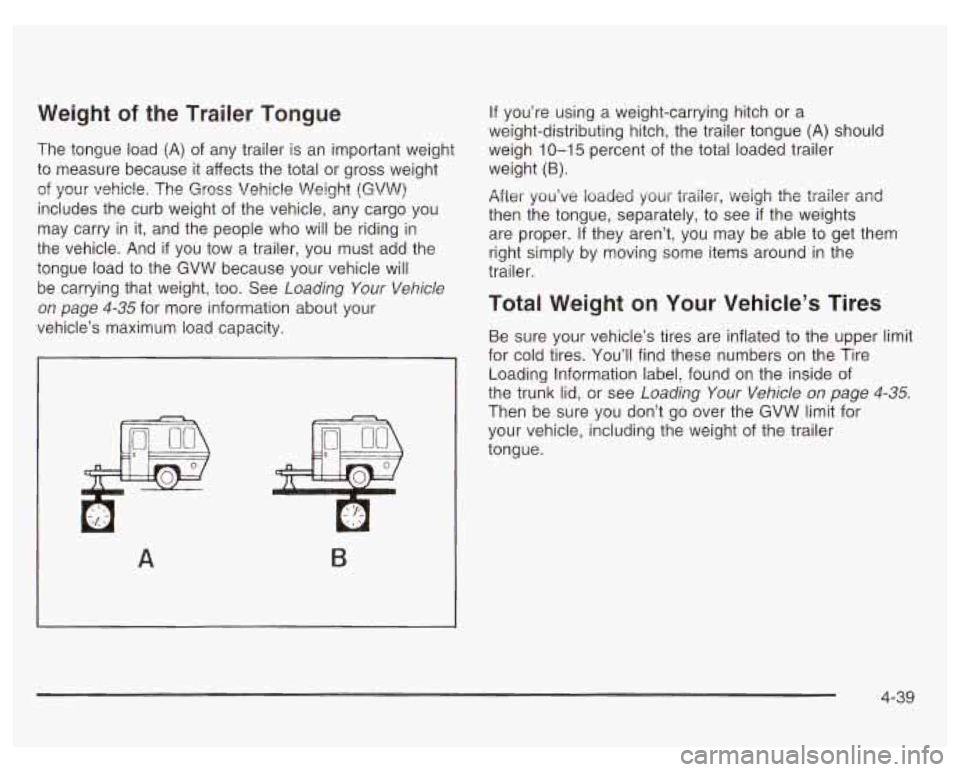
Weight of the Trailer Tongue
The tongue load (A) of any trailer is an important weight
to measure because it affects the total or gross weight
of your vehicle. The Gross Vehicle Weight (GWV)
includes the curb weight of the vehicle, any cargo you
may carry in it, and the people who will be riding in
the vehicle. And
if you tow a trailer, you must add the
tongue load to the GVW because your vehicle will
be carrying that weight, too. See Loading Your Vehicle
on page 4-35 for more information about your
vehicle’s maximum load capacity.
A
If you’re using a weight-carrying hitch or a
weight-distributing hitch, the trailer tongue
(A) should
weigh
10-15 percent of the total loaded trailer
weight
(B).
After you’ve loaded your trailer, weigh the trailer and
then the tongue, separately, to see if the weights
are proper.
If they aren’t, you may be able to get them
right simply by moving some items around in the
trailer.
Total Weight on Your Vehicle’s Tires
Be sure your vehicle’s tires are inflated to the upper limit
for cold tires. You’ll find these numbers on the Tire
Loading Information label, found on the inside of
the trunk lid,
or see Loading Your Vehicle on page 4-35.
Then be sure you don’t go over the GVW limit for
your vehicle, including the weight of the trailer
tongue.
4-39
Page 293 of 378
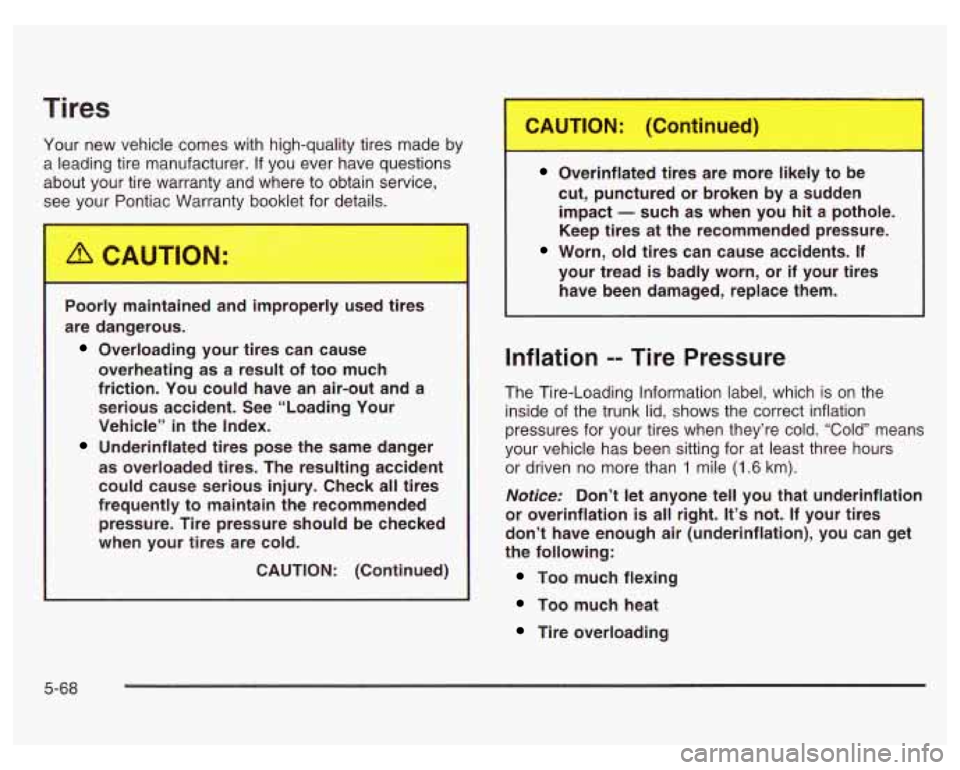
Tires
Your new vehicle comes with high-quality tires made by
a leading tire manufacturer.
If you ever have questions
about your tire warranty and where to obtain service,
see your Pontiac Warranty booklet for details.
. -orly mai __ and impropel used tires
are dangerous.
Overloading your tires can cause
overheating as a result of too much
friction. You could have an air-out and a serious accident. See “Loading Your
Vehicle” in the Index.
Underinflated tires pose the same danger
as overloaded tires. The resulting accident
could cause serious injury. Check all tires
frequently to maintain the recommended pressure. Tire pressure should be checked
when your tires are cold.
CAUTION: (Continued)
Overinflated tires are more likely to be
cut, punctured or broken by a sudden
impact
- such as when you hit a pothole.
Keep tires at the recommended pressure.
Worn, old tires can cause accidents. If
your tread
is badly worn, or if your tires
have been damaged, replace them.
Inflation -- Tire Pressure
The Tire-Loading Information label, which is on the
inside of the trunk lid, shows the correct inflation
pressures for your tires when they’re cold. “Cold” means
your vehicle has been sitting for at least three hours
or driven no more than
1 mile (1.6 km).
Notice: Don’t let anyone tell you that underinflation
or overinflation
is all right. It’s not. If your tires
don’t have enough air (underinflation), you can get
the following:
Too much flexing
Too much heat
Tire overloading
5-68
Page 310 of 378
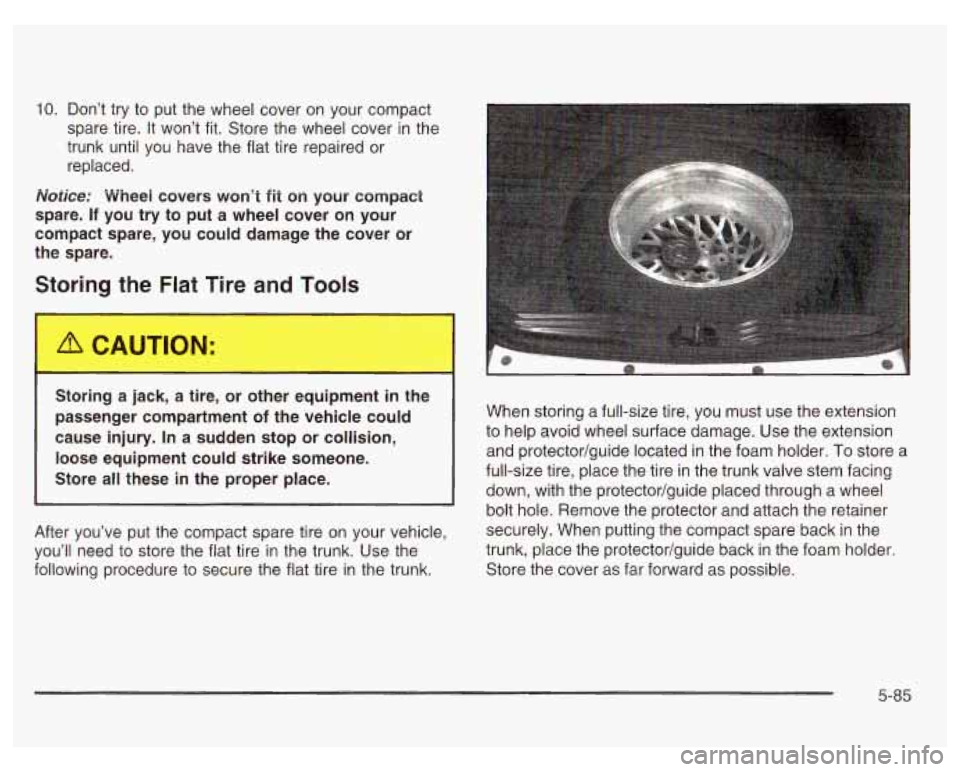
10. Don’t try to put the wheel cover on your compact
spare tire. It won’t fit. Store the wheel cover in the
trunk until you have the flat tire repaired or
replaced.
Notice: Wheei covers won’t fit on your compact
spare.
If you try to put a wheel cover on your
compact spare, you could damage the cover or
the spare.
Storing the Flat Tire and Tools
Storing a jack, a tire, or other equipment in the
passenger compartment
of the vehicle could
cause injury.
In a sudden stop or collision,
loose equipment could strike someone.
Store all these
in the proper place.
After you’ve put the compact spare tire on your vehicle,
you’ll need to store the flat tire in the trunk. Use the
following procedure to secure the flat tire in the trunk. When
storing a full-size tire, you must use the extension
to help avoid wheel surface damage. Use the extension
and protector/guide located in the foam holder.
To store a
full-size tire, place the tire in the trunk valve stem facing
down, with the protector/guide placed through a wheel
bolt hole. Remove the protector and attach the retainer
securely. When putting the compact spare back in the
trunk, place the protector/guide back
in the foam holder.
Store the cover as far forward as possible.
5-85
Page 370 of 378

Radios (cont.) Setting the Time
..................... .......... 3-44
Theft-Deterrent
............................................ 3-54
Understanding Reception
.............................. 3-57
Rear Assist Handle Reading Lamps
................... 3-14
Rear Safety Belt Comfort Guides
...................... 1-26
Rear Seat Outside Passenger Positions
............. 1-23
Rear Storage Area
.......................................... 2-41
Rear Window Defogger
.................................... 3-22
Rearview Mirror, Automatic Dimming with
Compass and Temperature Display
................ 2-34
Rearview Mirror, Automatic Dimming with Onstar@,
Compass and Temperature Display
.................. 2-33
Rearview Mirrors
............................................. 2-33
Reclining Seatbacks
.......................................... 1-4
Recreational Vehicle Towing
................... ... 4-33
Remote Driver Unlock Control
................. ... 2-48
Remote Keyless Entry System
............................ 2-4
Remote Keyless Entry System, Operation
............ 2-5
Remote Lock and Unlock Confirmation
............... 2-49
Remote Trunk Release
.................................... 2-1 2
Removing the Flat Tire and Installing
the Spare Tire
............................................. 5-80
Removing the Spare Tire and Tools
................... 5-77
Removing Wheel Covers and Wheel Nut Caps
...... 5-79
Replacement Bulbs
......................................... 5-66
Replacing Brake System Parts
.......................... 5-52
Rear Seat Passengers.
Safety Belts
.................. 1-22 Replacing Restraint
System Parts
Reporting Safety Defects After
a Crash
.............................................. 1-58
Canadian Government
................................... 7-9
General Motors
............................................. 7-9
United States Government .............................. 7-9
Checking Your Restraint Systems
.... .... 1-58
Replacing Restraint System Parts
After a Crash
........................... .... 1-58
Restraint
System Check
................ ........ 6-10
Restraint Systems
Checking
.................................................... 1-58
Replacing Parts
........................................... 1-58
Restraints, Head
............................................... 1-6
Retained Accessory Power (RAP)
...................... 2-20
Right Front Passenger Position, Safety Belts
...... 1-20
Roadside Assistance Program
....................................... 7-5
Rocking Your Vehicle To Get It Out
................... 4-32
Running Your Engine While You Are Parked
....... 2-32
S
Safety Belt
Safety Belts Reminder
Light
............................................ 3-26
Care of
...................................................... 5-91
Center Passenger Position
............................ 1-21
Driver Position
............................................ 1-12
11